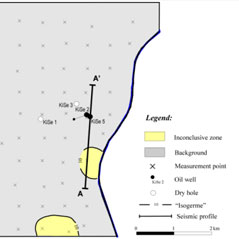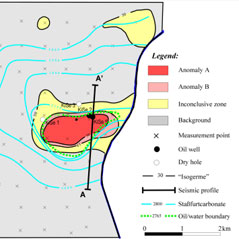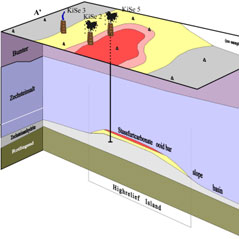Kietz (Germany)
Methodology
A microbial survey was carried out in the Kietz region (Germany) in 1995, as a wildcat exploration. Soil samples were taken at 197 measure points over an area of 120 km² and investigated according to the MPOG® process. The area is characterized ecologically as lowland, with many marshes and moist meadows.
Results
Figure 1 shows a section of the whole area investigated. Results for methane oxidizing bacteria show a background level and three small inconclusive zones in this region. There was no significant indication of methane. In contrast to methane indications, measured oil values showed significant indications for light hydrocarbons.
Figure 2 shows a selected section of the whole area with only one distinct microbial anomaly. Both oil production wells (KiSe 2, KiSe 5) are located within the microbial anomaly, whereas both dry wells (KiSe 1, KiSe 3) are located within the inconclusive zone. Position and extent of microbial anomalies are almost the same as the oil/water boundary determined by geoscientists after drilling.
Figure 3 shows the geological situation of the Kietz oil field in comparison to identified microbial anomaly. The oil of the Kietz field is trapped in an unfaulted paleomorphological Ca2 structure. About 800 m Zechstein salt is top layer of the reservoir. Light hydrocarbons were detected by MPOG® directly above the oil field and oil/water contact zone. There is no lateral derivation of detected hydrocarbons. Preferred pathways for hydrocarbon migration such as faults or fractures do not exist in Zechstein salt above the Kietz reservoir and therefore not essentially required for establishment of hydrocarbon anomalies.
No signs of methane were discovered above the field. This corresponds with the fact that the oil reservoir does not have a gas cap.
Summary
From 197 investigated samples, only 7 samples (3.5%) reached the level of oil anomaly "A" or "B" (more than 45 MU). 6 of the 7 samples with significant oil indications are located within a closed field directly above the detected oil-bearing structure.



